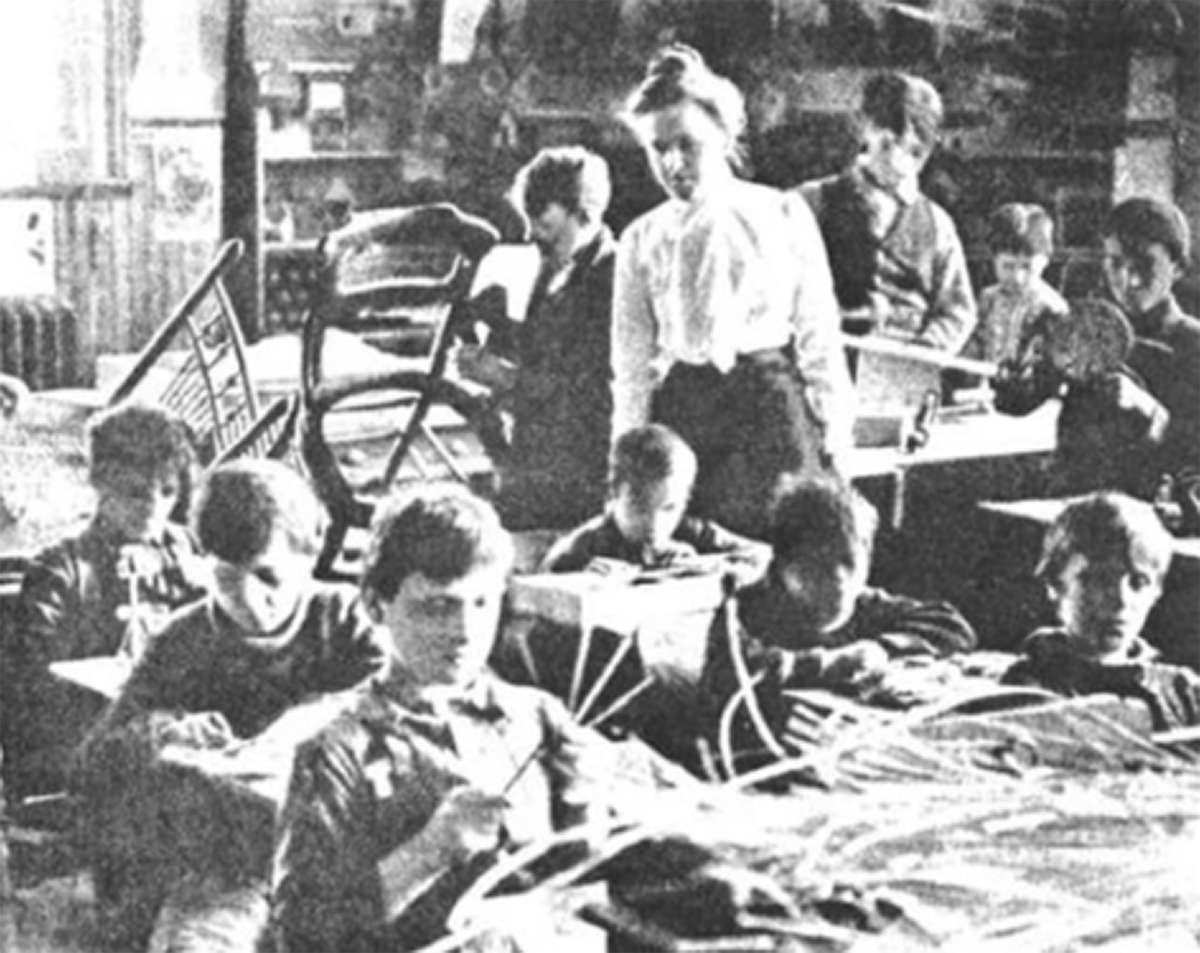Elizabeth Farrell and Ungraded Classes

Date: undated
Caption: Elizabeth Farrell oversees boys of different ages making furniture in a classroom.

Special education classes for children with intellectual disabilities were pioneered in New York City by a social welfare reformer, Elizabeth Farrell. Farrell had been working with Lillian Wald and other reformers at the Henry Street Settlement in the Lower East Side. Henry Street was built to provide community support and education to new immigrants to New York City, most of them from southern and eastern Europe.
Farrell found that some of her students responded better to more active kinds of instruction and a smaller class size. Based on the success she had in working with these children, she later proposed to establish an “ungraded class” at P.S. 1. Later she pushed to expand these classes to other schools throughout the system, and she became the Inspector of Ungraded Classes.1 She believed that behavior problems and truancy were linked to difficulties learning. She sent visiting teachers to speak with parents about their children’s needs.2
Ungraded classes were smaller than standard classes, which typically included at least 43 children.3 Most of the students in the ungraded classes had learning disabilities, and were taught with other children of varied ages. With new laws requiring school attendance, students who had previously been kept out of school were now attending. However, there were very few teachers who had training to teach children with learning disabilities, and the schools didn’t receive the funding and teachers needed to accommodate all students. Many children were labeled as “institutional cases” and their parents were encouraged to send them to Randall’s Island, or Letchworth Village, another nearby state institution for the disabled. Denied an appropriate free education for their children and lacking support to care for their children, parents often followed the advice of doctors and school officials and sent them away to institutions.4
Elizabeth Farrell believed that all children should have access to public education and disagreed with institutionalization. In the “ungraded classes” Disabled children were still segregated into separate classes, both to give more attention to their needs and to keep them away from “normal” children.5
Farrell later found herself defending her classes against criticism from Henry H. Goddard and Mary Dunphy, both of whom directed institutions for Disabled people. They argued for complete segregation of Disabled children into institutions like theirs.6
By the early 1930s, after an expansion in the use of intelligence testing, there were 11,000 students in ungraded classes throughout New York City public schools.7
-
Kimberly E. Kode, Elizabeth Farrell and the History of Special Education (Arlington, VA: Council for Exceptional Children, 2002), 33, https://eric.ed.gov/?id=ED474364. ↩︎
-
Kode, Elizabeth Farrell and the History of Special Education, 52. ↩︎
-
“New York City’s Schools and What They Cost; The Greatest System in the Country, Costing Annually Something Like $50,000,000, It Is Unable to Accomodate All Children Seeking an Education Here,” The New York Times, September 13, 1908. ↩︎
-
Margaret A. Winzer, The History of Special Education: From Isolation to Integration (Washington, DC: Gallaudet University Press, 1993), 139. ↩︎
-
Kode, Elizabeth Farrell and the History of Special Education, 34. ↩︎
-
Michael M. Gerber, “A History of Special Education,” in Handbook of Special Education (New York: Routledge Press, 2017), 3-15. ↩︎
-
“Elizabeth Farrell Dies in Cleveland; Founded Ungraded Class System in this City in This City, Starting with Small Group Now Numbers 11,000,” The New York Times, October 17, 1932, https://www.nytimes.com/1932/10/17/archives/elizabeth-farrell-dies-in-cleveland-founded-ungraded-class-system.html. ↩︎
Categories: K-12 organizing
Tags: racist segregation, Disabled people, intellectual disabilities, physical disabilities, disability labels, photography, imagery, and visual representation, institutionalization of Disabled people and people labeled disabled, school facilities
This item is part of "The Beginnings of Special Education" in "Seeking Equity for Disabled Students"
Item Details
Date: undated
Creator: Board of Education of the City of New York
Source: Council for Exceptional Children
Copyright: Public domain
How to cite: “Elizabeth Farrell and Ungraded Classes,” Board of Education of the City of New York, in New York City Civil Rights History Project, Accessed: [Month Day, Year], https://nyccivilrightshistory.org/gallery/elizabeth-farrell.
Questions to Consider
- How did compulsory education laws change the way children with disabilities were educated?
- Who determined whether a child was able to go to public school or sent to a state institution? What were some of the dilemmas for parents of Disabled children at this time?
References
How to Print this Page
- Press Ctrl + P or Cmd + P to open the print dialogue window.
- Under settings, choose "display headers and footers" if you want to print page numbers and the web address.
- Embedded PDF files will not print as part of the page. For best printing results, download the PDF and print from Adobe Reader or Preview.
